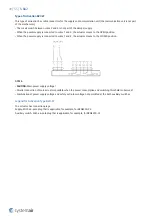
53/55 |
S-BA2
Do not change the dampers or their structure without the approval of the manufacturer.
The actuator keeps the dampers on stand-by during their life cycle. The operator obeys the applicable regulations and
standards to do regular checks of the dampers. The recommended minimum interval for the inspection checks is 6
months. The manufacturer and/or government authorities must approve the inspecting person and/or process for this
inspection. Operating Journal must be kept during the lifecycle of the smoke control damper. The damper's Operating
Journal includes a copy of the approval/s of the inspecting person. If the inspecting person finds differences, the
operator must write these differences in the Operating Journal. Then, he must recommend action to remove these
differences.
After you install and start the damper, immediately do an initial check. This check obeys the same conditions as the
six-month inspections.
Do a check of these elements of the external side of the damper:
• The damper housing
• The actuator movement.
NOTE:
To do a visual check of the internal parts of the damper, dismount the inspection lid or the grille. This will give
you access to the internal parts. Also, if the damper has an mechanism lid, you can open the lid to access the internal
parts.
Do a check of these items of the internal side of the damper:
• Make sure that there are no foreign objects or layers of contamination in the air distribution systems of the damper.
• The internal casing of the damper
• The sealings
• The foaming material
• The condition of the damper blade
• How accurately the damper blade closes when it is against the backstop in the closed position.
Recommended Procedure for the Inspection Log (refer to EN 12101)
1. Find the identification of the damper.
2. Write the date of the inspection.
3. Examine the actuator wiring for damage.
4. Examine the wiring of the end switches for damage.
5. Make sure that the damper is clean. If necessary, clean the damper.
6. Do a check of the inspection lid and of the tightness of the cover.
7. Do a check of the blade and of the sealings. If necessary, correct the defects and record the results (where
applicable).
8. Do a functional test of the damper (open and close) (refer to the “Smoke Damper Functionality Check” chapter).
9. Confirm the operation of the damper with the control system:
a. Monitor the physical performance of the damper
b. Monitor the signals of the end positions.
c. If necessary, correct and record the defect (where applicable).
10. The damper is part of the SHEVS (Smoke and Heat Exhaust Ventilation System). Thus, you must do a check of the
full system (refer to the Operational and Maintenance Requirements).
11. Set the system to the operating position (refer to the “Operation Manual”).
12. Record the result in the “Operating Journal” with the name and the signature of the Inspection Technician.
After the inspection, the inspecting person must write the data that follows in the “Operating Journal”:
• Condition of the damper
• Date of the inspection
• Name, Surname and Signature of the employee that did the inspection (make sure that you can read this data).
Содержание A-S-BA2
Страница 1: ...S BA2 Smoke Control Damper AA multi Handbook...
Страница 19: ...19 55 S BA2 5 1 1 2 B A1 A2 3 A1 B A2...
Страница 20: ...20 55 S BA2 C 4 1 8 1 Fx C1 C2...
Страница 21: ...21 55 S BA2 F3 5 2 D E F3 D1 D2 5 E1 E2 6...
Страница 55: ...Systemair DESIGN 2021 09 16 Handbook_S_BA2_en GB...























